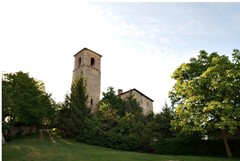Municipality of Pavullo.
Chasing down history: The villages of Semese, Lavacchio and Gaiato
Our exploration takes us towards other small villages high in the hills brimming with history and human tales.
Perched on a mount at 803m above sea level, the Castle of Semese dominates the wide Verica valley, in visual contact with many other castles and towers of Frignano’s ancient defence system. Because of its privileged geographical position, naturally suited to observation and signalling, Semese was already inhabited in Neolithic times, as shown by archaeological finds from the area.
The castle settlement dates back to the 13th century, but it is likely that the main building already existed in the previous century. Long under the dominion of the powerful Da Verica family, in the 13th century the fiefdom became part of the possessions of the Montecuccoli family who saw to strengthening its fortifications.
Towards the end of the 1300s the feudatory lord of Semese was Lanzillotto Montecuccolo, a man with a violent and arrogant nature, who waged a long and bloody dispute with his cousin Gaspare, lord of Montecuccolo over an inheritance. Gaspare was to die suddenly and Lanzillotto took possession of his dominions, pitilessly putting to death his young sons, Corsino and Antonio, by having them thrown into the castle’s deep cistern.
Lanzillotto went unpunished and went on to become the powerful owner of a large part of the Montecuccoli’s fiefdom. In 163o, Francesco Montecuccoli returned the Semese fiefdom to the ducal chamber receiving in exchange that of Guiglia.
From the castle there is a stunning panorama: On the one side the Apennine ridge dominated by Mount Cimone, on the other the valley which the Scoltenna stream winds through.
The castle, currently a private residence, consists of various buildings that frame the ancient courtyard, however centuries ago its architecture was much more complex: the main entrance featured a drawbridge and a ravelin, a special kind of fortification built to defend the main gate.A drawing from the early 160os shows the castle with four towers. The main one, built on top of former early-medieval fortifications, was substantially lowered in the 1500s and turned into a belltower.
Also the village, clustered around a large grassy squares, contains some interesting examples of architecture.
The Church of San Giacinto, currently a private residence, was commissioned by Enea Montecuccoli and built in 1598 on top of an earlier building. The five niches that adorn the elegant façade contained as many statues, currently to be found at the parish church of Verica, and attributed to the sixteenth-century sculptor, Antonio Begarelli, or his school.
A stone’s throw away, to the north of the castle, lies the small oratory of San Rocco, restored by Enea Montecuccoli, as testified by the plaque walled into the façade. An act of devotion on the occasion of the great outbreak of plague that struck the fiefdom in the early 1600s. This ancient building may even date back to the 1400s, but some theories place it in an earlier age dedicated to pagan worship and only later turned into a chapel in the Romanesque period.
Gaiato
Continuing southwards, we can enjoy a stroll through the unspoilt nature of the Sassoguidano Nature Reserve, to then head for the village of Gaiato, a medieval settlement that belonged to the fiefdom of the Montecuccoli.
When the sons of Count Frignano split the extensive estate up with two successive agreements in 1536 and 1544, Gaiato and Renno went to Andrea, who became progenitor of the homonymous family of counts.
Where the village is highest, in a strategic position to control the Scoltenna, Panaro and central Frignano valleys, rises the Gaiato Tower. Built in Matilda of Canossa’s times on top of earlier Roman and Byzantine fortifications, it was enlarged and fortified by the Montecuccoli family who from the 1400 to 1500s turned it into a proper fortress of which nowadays all that exists are the crumbling tower, two cisterns and remains of the walls.
Lavacchio
Further on we reach Lavacchio, whose tower rises proudly to dominate a landscape that was once the dominion of the powerful Montecuccoli family.
A watchtower along the Modena-Pistoia road, it preserves characteristic elements of the original structure, such as the raised portal and two ledges that supported the trapdoor used by the guards for machicolation, a system that made it possible to drop stones, pitch or other incandescent liquids on any enemies that attempted to climb the protective walls. Another characteristic curiosity are the modern murals painted on the walls of the village houses.
